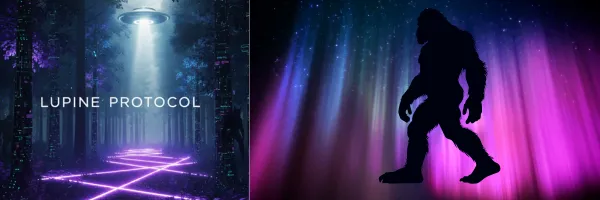

The Science Behind The Legend
Scientific Analysis of the Patterson-Gimlin Film
Dossier Contents
- Abstract
- Introduction and Historical Context
- Biomechanical and Anatomical Evidence
- Special Effects and Costume Technology Analysis
- Digital Analysis and Enhancement Studies
- Skeptical Investigations and Alternative Explanations
- Environmental and Contextual Evidence
- Contemporary Technological Investigations
- Current Scientific Consensus and Future Directions
- Conclusion
Abstract
The Patterson-Gimlin film, captured on October 20, 1967, represents one of the most extensively analyzed pieces of alleged cryptozoological evidence in scientific literature. This 59.5-second 16mm film footage, purporting to show an unknown bipedal hominid in the wilderness of Northern California, has been subjected to nearly six decades of multidisciplinary scientific scrutiny. Through biomechanical analysis, digital enhancement techniques, anatomical assessment, and technological investigation, researchers have attempted to determine whether the filmed subject represents an unknown species or an elaborate hoax. This comprehensive review examines the methodologies, findings, and ongoing debates surrounding this controversial piece of evidence.
Introduction and Historical Context
On a crisp October morning in 1967, Roger Patterson and Bob Gimlin set out on horseback into the remote wilderness of Bluff Creek, California. The resulting film, consisting of 953 individual frames, would become the most analyzed piece of alleged cryptozoological evidence in scientific history. The footage shows what appears to be a female hominid, estimated at between 6 feet 6 inches and 7 feet 4 inches in height, displaying a distinctive gait pattern as it traverses the sandy creek bed. At frame 352, the creature turns to look directly at the camera, providing what proponents argue is clear evidence of facial features inconsistent with known primates. For a full narrative of the encounter, see our main case dossier.
Biomechanical and Anatomical Evidence
The scientific examination of the film has been dominated by biomechanical analysis, primarily led by Dr. Jeffrey Meldrum of Idaho State University and the late Dr. Grover Krantz of Washington State University. Their analyses reveal several compelling anatomical features that distinguish the filmed subject from known human morphology.
Dr. Meldrum's analysis reveals what he terms a "compliant gait" mechanism. This energy-efficient walking style, characterized by a bent-hip, bent-knee locomotion pattern, represents an adaptation typically associated with large-bodied primates but rarely observed in human walking. The stride length, calculated through photogrammetric analysis, suggests steps averaging approximately 41 inches, requiring unusual limb proportions to achieve efficiently.
Enhanced digital examination reveals apparent flexibility in the midfoot region during the walking cycle, suggesting a foot structure more similar to that of great apes than humans. This "midtarsal break" allows for more efficient energy transfer during locomotion in creatures with large body masses. Dr. Krantz's examination focused on the creature's overall body proportions and muscle mass distribution, noting the apparent development of a sagittal crest along the skull's midline, common in large primates like gorillas for anchoring powerful jaw muscles.
Special Effects and Costume Technology Analysis
The question of whether the film could represent an elaborate costume hoax has been investigated by professionals from Hollywood's special effects community. Bill Munns, a creature suit fabricator, has conducted perhaps the most comprehensive technical analysis of the costume hypothesis.
Munns' examination addresses the technological limitations that would have constrained any potential hoax attempt in 1967. The era's costume technology relied heavily on rigid foam padding and basic fur application techniques. Digital enhancement of the original film reveals what appears to be individual muscle groups contracting and relaxing during locomotion, particularly in the thigh and buttock regions. Achieving this would have required sophisticated mechanical systems or advanced materials exceeding the capabilities of 1960s special effects technology.
The natural movement of apparent mammary tissue and the visible bone structure beneath the skin on the face would have also required sophisticated prosthetic techniques beyond the reach of most costume makers of the era.
Digital Analysis and Enhancement Studies
The advent of digital technology has allowed for unprecedented examination of the film's details. Digital stabilization algorithms have been applied to reduce camera shake, revealing anatomical details previously obscured. These enhanced versions show what appears to be natural hair flow and movement patterns consistent with actual fur rather than synthetic materials.
Frame interpolation studies, designed to analyze the smoothness of the creature's movement, have generally supported the authenticity position. The locomotion patterns show consistent biomechanical relationships between different body segments throughout the walking cycle, suggesting either genuine biological movement or extraordinarily sophisticated choreography and costume design.
Skeptical Investigations and Alternative Explanations
The scientific principle of extraordinary claims requiring extraordinary evidence has driven extensive skeptical investigation, focusing on the possibility of a hoax.
The costume hypothesis has been championed by several researchers, most notably those associated with the Committee for Skeptical Inquiry. The primary claim is that the film depicts a man named Bob Heironimus in a suit, who came forward in 1999. However, Heironimus's claims have been challenged by inconsistencies in his timeline and his inability to provide physical evidence.
The motivational analysis focuses on Roger Patterson's financial difficulties. However, critics of the hoax hypothesis point out that the risks involved in creating such an elaborate deception might outweigh the potential benefits. Dr. David Daegling of the University of Florida has provided anthropological perspective on the skeptical side, arguing that the evidence presented falls short of the standards required for species identification.
Environmental and Contextual Evidence
The Bluff Creek area had been the site of numerous large footprint discoveries throughout the 1950s and 1960s, creating a context of reported anomalous activity that preceded the film. Footprint casts taken at the scene show remarkable detail, including apparent dermal ridges and toe flexibility markers. Some experts argue that the level of anatomical detail suggests genuine biological origin. However, skeptical researchers have demonstrated that convincing footprint casts can be created using artificial methods.
Contemporary Technological Investigations
Recent advances in artificial intelligence and machine learning have opened new avenues for analyzing the film. Computer algorithms trained to recognize biological movement patterns have been applied to the footage, with preliminary results suggesting movement characteristics that don't precisely match human locomotion databases. Spectral analysis of the original film has also been conducted to detect potential signs of composite imagery or post-production manipulation, finding no evidence of such.
Current Scientific Consensus and Future Directions
The scientific community remains deeply divided on the Patterson-Gimlin film's authenticity. Proponents, led by researchers like Dr. Meldrum, argue that the biomechanical and anatomical evidence exceeds what could reasonably be expected from a 1967 hoax. Skeptical researchers maintain that the absence of corroborating physical evidence, combined with the human capacity for creating convincing hoaxes, requires that extraordinary caution be applied.
Conclusion
The Patterson-Gimlin film represents a unique case study in the application of scientific methodology to cryptozoological evidence. After nearly six decades of multidisciplinary analysis, the footage continues to generate legitimate scientific debate among qualified researchers, suggesting that the question of its authenticity cannot be dismissed through simple explanations.
Whether the film ultimately represents genuine evidence of an unknown primate species or an extraordinary example of mid-20th century hoax creation, its impact on both cryptozoological research and scientific methodology has been profound. The rigorous analysis applied to this case has established protocols for evaluating similar claims and highlighted the importance of maintaining scientific skepticism while remaining open to genuine discoveries that might challenge existing paradigms.
Explore The Mysteries
welcome to the central archive. Lupine Protocol is a unified platform dedicated to the methodical investigation of unexplained phenomena. We bring a data-driven, evidence-based approach to the subjects that exist on the fringes of conventional science. Whether you're a seasoned researcher or a curious newcomer, our mission is to provide the resources, tools, and in-depth analysis you need to explore the world's most enduring mysteries.

Cryptozoology

UFO/UAP

The Unexplained

"Whether you're documenting the undocumented, investigating the inexplicable, or just addicted to the unknown—this is where legends are born."

Pages
Listed On


Information

© 2025 ward media projects - All Rights Reserved.



